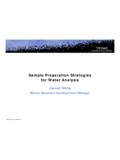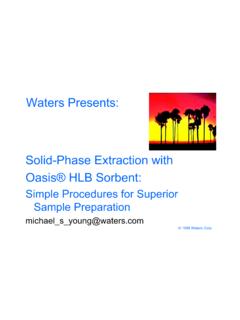Transcription of Measurement of personal exposure of metalworking …
1 Scope1 This method describes a procedure for the Measurement of time-weighted average concentrations of water -mix metalworking fluid originating from metalworking machine operations. The method is only suitable when the machine sump fluid (liquid circulating in the machine ) contains an element which is unlikely to emanate from a source other than the water or metalworking fluid concentrate used to prepare the fluid and this element is present at a high enough concentration to facilitate its use as a Elements that have been found to be suitable markers are boron, potassium and A measured volume of air is drawn through a filter mounted in an inhalable aerosol sampler. The filter is then desorbed with caesium chloride The concentration of the marker element in the filter samples and a sample of the sump fluid can then be measured by either flame atomic absorption spectrometry (AAS) or inductively coupled plasma atomic emission spectrometry (ICP-AES).
2 5 The strength of water -mix metalworking fluid in the sump is then measured by comparison of refractometry results of the sump fluid with solutions of known strength prepared from the concentrate used to prepare the metalworking Together these measurements allow the calculation of the concentration of the metal working fluid concentrate in the air The use of alternative methods not included in the MDHS series is acceptable provided they can demonstrate the accuracy and reliability appropriate to the sampling8 A minimum sampling time of 2 hours is recommended when boron or potassium is the marker element; and a minimum sampling time of 8 hours is recommended when sodium is the marker element.
3 However, if sampling is carried out in a dusty environment, the sampling time should not be so long as to risk overloading the filter. An 8-hour time weighted average concentration may be derived from the results for two or more consecutive Advice on monitoring strategies for toxic substances is given in and Safety ExecutiveMeasurement of personal exposure of metalworking machine operators to airborne water -mix metalworking fluidElemental marker method using flame atomic absorption spectrometry or inductively coupled plasma atomic emission spectrometryMethods for the Determination of Hazardous Substances Health and Safety LaboratoryHealth and Safety ExecutiveMeasurement of personal exposure of metalworking machine operators Page 2 of 16to airborne water -mix metalworking fluid9 If employing background
4 Sampling, samplers should be positioned at approximately head height, away from obstructions, fresh air inlets or strong winds. The sampling procedures are otherwise the same as for personal The examples of the lower limit of the working range of the method given in Table 1 (Appendix 1) may be used to estimate the minimum sampling time required to enable personal exposure measurements to be made with acceptable expanded uncertainty at the concentration of water -mix metalworking fluid concentrate in air of interest, eg A more accurate assessment of the minimum sampling time required can be achieved by following the procedure described in Appendix 2. If in doubt, sample for at least 4 hours and preferably over a full working Users of this method will need to be familiar with the content of Users of this method should be familiar with standard laboratory practice and carry out a suitable risk assessment.
5 It is the user s responsibility to establish appropriate health and safety practices and to ensure compliance with regulatory Inhalable aerosol samplers with protective cover as described in The samplers should be cleaned and operated according to the manufacturer s personal sampling pumps that meet the requirements of BS EN Filters: Quartz fibre filters should be used when boron is the marker For sodium or potassium, filters with a retentivity of not less than for particles with a m diffusion diameter are required. Mixed cellulose ester filters of m mean pore diameter are suitable. 16 A portable flow meter calibrated against a primary standard, with a Measurement uncertainty typically less than 2%.
6 17 Flexible plastic tubing of a suitable diameter for making a leak-proof connection from the sampling head to the pump; flat-tipped tweezers for loading and unloading the filters into samplers; and filter transport cassettes and containers to transport samples to the laboratory. Laboratory apparatus and reagents18 During the analysis use only reagents of a recognised analytical grade. Use only deionised water : Complying with the requirements of ISO 36966 grade 2 water (electrical conductivity less than and resistivity greater than M .m at 25 C20 Concentrated nitric acid (HNO3): Density about (69% 71% (m/m)).Health and Safety ExecutiveMeasurement of personal exposure of metalworking machine operators Page 3 of 16to airborne water -mix metalworking fluid21 Dilute nitric acid (10%): Add approximately 800 ml of water to a 1 litre volumetric flask.)
7 Carefully add 100 ml of concentrated nitric acid and swirl to mix. Allow to cool, dilute to the mark with water , stopper and mix Stock standard solutions of sodium, potassium and boron (1000 ): Use commercially available standard solutions. Observe the manufacturer s expiry date and storage Working standard solutions (100 ): Accurately pipette 5 ml of stock standard solution into a 50 ml volumetric flask, dilute to the mark with water and mix thoroughly. Prepare these solutions fresh Caesium chloride solution, approximately (m/v): Dissolve g of caesium chloride in water . Quantitatively transfer the solution into a 1 litre volumetric flask, dilute to the mark with water and mix thoroughly.
8 This solution may be stored in a polypropylene bottle for an indefinite Cellulose filter Laboratory detergent solution: Suitable for cleaning of laboratory glassware, diluted with water according to the manufacturer s Borosilicate laboratory glassware (suitable plastic beakers may also be used): Beakers; funnels; watch glasses; measuring cylinders; and volumetric flasks complying with the requirements of BS ISO Cleaned before use with laboratory detergent and laboratory washing machine followed by rinsing with water . An additional cleaning by soaking in the 10% nitric acid for at least 24 hours and then thoroughly rinsing with water is Micropipettes complying with the requirements of BS EN 29 Orbital mixer: variable Polypropylene bottles: with screw cap for collection of bulk samples, cleaned by soaking in 10% nitric acid for at least 24 hours and rinsed with water .
9 Bottles made of an alternative plastic may be used provided that they are suitable for the intended Spectrometer: Either an atomic absorption spectrometer (AAS), fitted with an air-acetylene burner, supplied with compressed air and acetylene, and equipped with a sodium or potassium hollow cathode lamp or an inductively coupled plasma atomic emission spectrometer (ICP-AES), supplied with argon, and capable of measuring boron at nm (or an alternative suitable wavelength).32 Refractometer: Capable of measuring the refractive index of water -mix metalworking fluids over a suitable range of fluid strengths (eg 0 10%), with a graduated scale having divisions or better. Preparation and sampling33 Preparation of samplers and air sampling should be carried out in accordance with the procedures described in MDHS143 for inhalable aerosol.
10 34 Consult the material safety data sheet for information on the composition of the metalworking fluid and select quartz fibre filters if boron will be the marker element, otherwise mixed cellulose ester membrane filters may be used. Boron or potassium are suitable for use as the marker element if present in the sump fluid at Health and Safety ExecutiveMeasurement of personal exposure of metalworking machine operators Page 4 of 16to airborne water -mix metalworking fluida concentration of at least 100 , while sodium concentration must be at least 400 However, avoid using sodium, where possible, since the lower limit of the analytical range is much higher than for boron or potassium, and there is a greater likelihood of interference from secondary sources of sodium in the workplace.
















